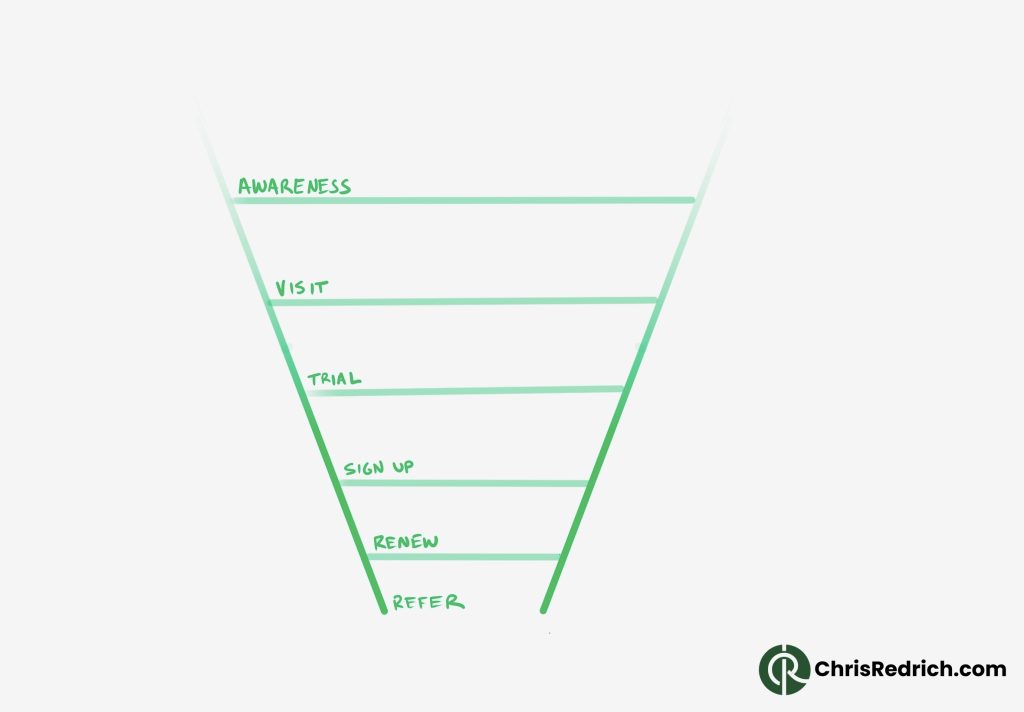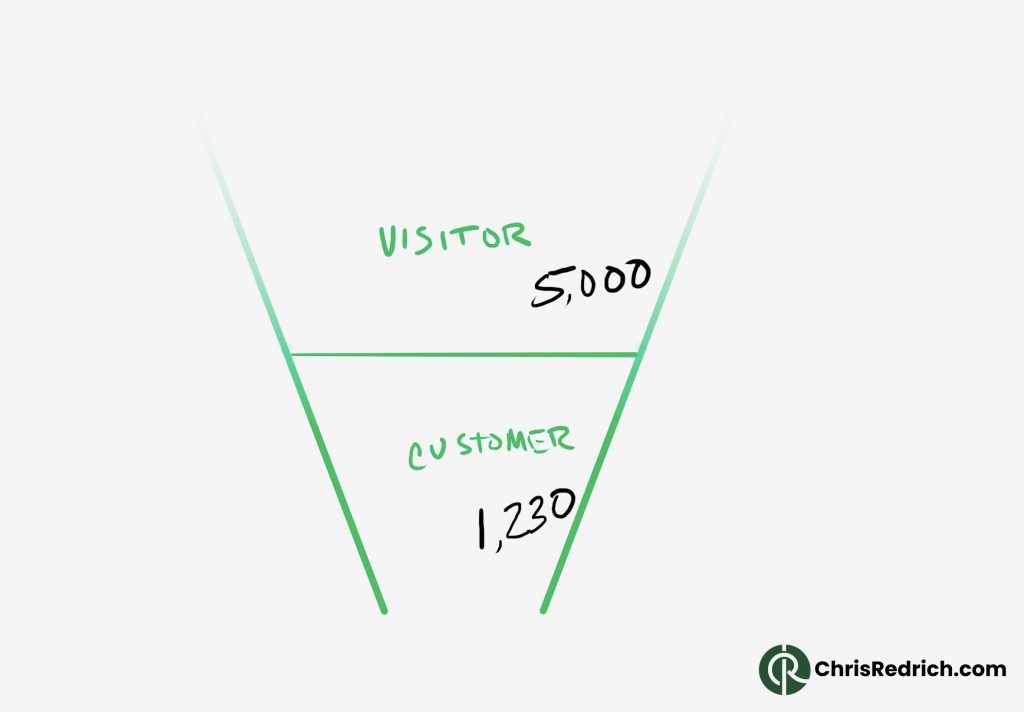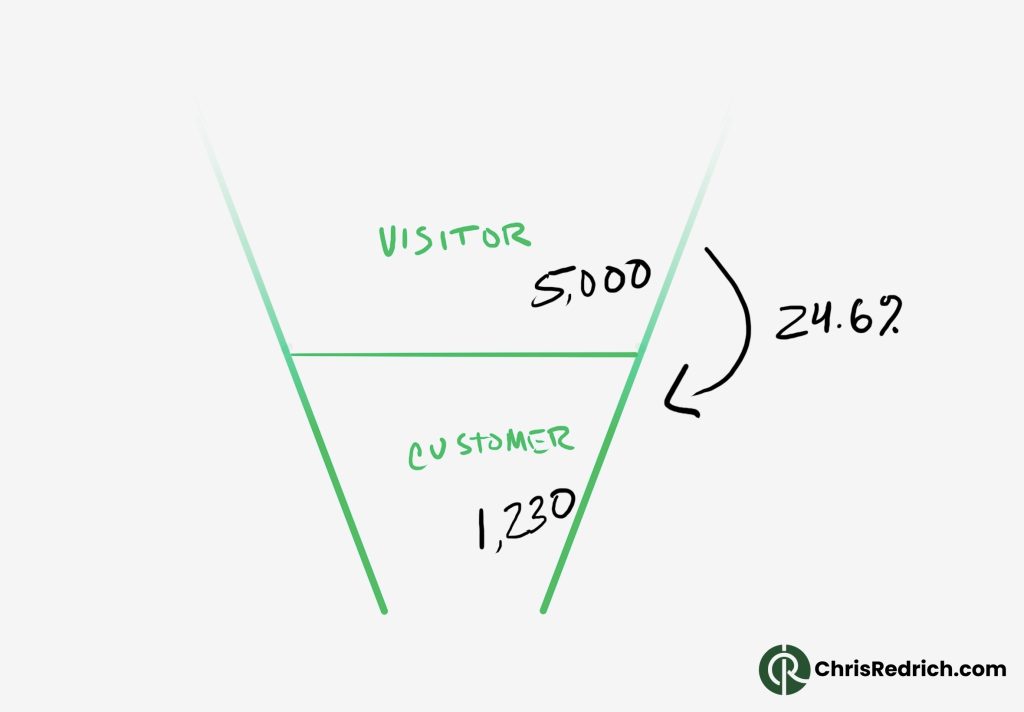Understanding your customer acquisition funnel is essential to building and growing any business. As a founder, leader, or executive, you must intimately understand the funnel of your business.
I would argue that mapping your ideal customer funnel before building your product or business will accelerate your path to revenue. This allows you to build the best customer experience from day 1 instead of trying to diagnose and fix funnel problems later on.
While often labeled as marketing funnels or flywheels, I call them ‘business funnels,’ underscoring their fundamental role in any online venture.
What Is A Business Funnel?
A business funnel is the steps a person will take to go from completely unaware of your business to happy and satisfied (and hopefully recommending!) with your product or service.
They often look something like these examples. But they don’t need to be visual. In fact, even a simple list of steps will do. The point is to have an understanding of your customer’s journey.
An overly simplistic funnel can look like this. This is a funnel in its most primitive form. It depicts a person going from visitor to customer.

A thorough and well-understood funnel might look something like this.

The Imperative of Understanding Your Business Funnel
Every online business, regardless of size or sector, operates with one or more inherent funnels. These funnels are more than just a pathway from visitor to contact; they are the lifeblood of customer engagement and conversion.
Let’s look at some examples of how you can map a funnel for any type of business.
A Physical (Completely Offline) Retail Store
- People passing by (walking or driving)
- People who enter the store
- People who enter the checkout line
- People who make a purchase
- People who come back
A Freelancer Who Offers Hourly and Retainer Services
- Impressions on social media / Ad impressions / Profile views
- Visitors to their website
- Submit a contact form
- Book an intro call
- Conduct an intro call
- Hourly project
- Retainer client
An Etsy Shop
- Search impressions
- Click to product
- Add to cart
- Checkout
A Content Creator Who Sells Merch
- Views
- Follower
- Link In Bio clicks
- Email list subscriber
- Merch purchased
Your Funnel Is A Strategic Roadmap
A well-understood funnel is a powerful tool, illuminating the pathway to business success. It dispels the fog of operational uncertainty, offering clear insights into performance and potential growth areas.
Once you map your funnel, you will start to see your business differently. For many of my clients, the funnel serves as a key strategic asset to drive prioritization daily, weekly, monthly, and annually. It helps you to clarify where to spend your time.
I can’t even count the number of times I have heard from founders, “If I could just get the message out.” It pains me every time I hear it because it is a myopic focus on only one point of the funnel – the very top.
Don’t get me wrong, the top of the funnel is absolutely critical. But assuming you have a steady flow of traffic at the top of the funnel, you should first understand your full funnel before aggressively filling the top of your funnel.
Having an in-depth understanding of your customer funnel is crucial for anyone striving to grow a business online. Mapping and improving your business funnel can:
- Increase revenue by highlighting areas where your customers are getting lost.
- Better understand your business and the things you can change.
- Feel more in control of your destiny and growth.
- Improve your understanding of your customer and their journey to you.
- Create focus and bring order to the chaos of business.
Measuring Funnel Performance
The numbers within your funnel tell a compelling story about your business growth and potential. Funnel metrics can provide an exhaustive overview of your business’s health and trajectory.
The steps in your funnel describe the story of your customer’s journey. The measurement of these steps tells the story of your business journey.
Let’s take a look at a few common measurements we’ll use when building your funnel.
Whole Numbers

Conversion Rate
This critical metric tracks the percentage of prospects who take a desired action, moving from one stage of the funnel to the next. Understanding conversion rates at each stage allows you to pinpoint areas needing improvement.
Here is how we calculate the conversion rate of each funnel step.
Conversion Rate = (Step 2 / Step 1) * 100
Let’s take our simplistic funnel from earlier and calculate the conversion rate from Visitor to Customer.
Conversion Rate = (1230 / 5000) * 100 = 24.6%
Cost Per [acquisition/customer/lead/click]
Fill in the specific metric relevant to your business (e.g., acquisition, lead, or click). This measurement helps you assess the cost-effectiveness of your marketing efforts in acquiring a customer, generating a lead, or driving a click. Analyzing this cost gives insights into the efficiency of your marketing strategies and can guide budget allocation.
Step-by-Step Guide to Mapping Your Funnel
Building an effective business funnel is a journey from broad understanding to precise strategy. Here, I will guide you step-by-step in constructing your funnel, from envisioning the customer’s initial unawareness to their ultimate satisfaction. This process will help you map out the critical stages of the customer journey.
Start With A Blank Canvas
Begin by taking out a sheet of paper or using the one-page worksheet provided below. This blank canvas will serve as the foundation for your funnel mapping.
1. List Every Step From Oblivious To Rabid Fan
Put yourself in the shoes of your target customer, user, or donor who is completely unaware of your business. Now imagine their journey from encountering a problem, seeking a solution, discovering your business, and becoming a customer.
We will document every step of the customer’s journey, from oblivious to your business to becoming a rabid fan.
Unaware
Every prospect starts out as completely unaware of your business. They have a problem but haven’t yet found your business, product, or solution.
You likely won’t have a step in your funnel for this stage of the customer journey. You can think of this as Total Addressable Market (TAM), which is the universe of possible customers for your business. For most businesses, quantifying this stage will be difficult and not all that valuable.
The important part of this stage of your funnel is to know that there is a universe of people out there who are completely unaware of your business.
So, let’s begin by mapping the path of discovery. Begin to list out every step you, as an unaware customer, would take to discover your business, product, or solution.
Discovery: Unaware to Aware
Where and how does your target audience become aware of your business? Consider avenues like social media, Google searches, and the specific queries they might use. Write down each step. A list is just fine for now.
Think about all of the channels your target customer might find you in. Online communities, X/Twitter, TikTok, LinkedIn, etc. For now, focus on your existing channels. Remember, our goal with this mapping exercise is to map the current state of your business so we can identify areas to improve/expand.
Once a person finds your business, they become “aware.” Meaning that they now know you exist. They may not be ready to purchase yet, but they at least know about your business.
Awareness to Interest
Now, envision the steps a potential customer takes upon finding your business online. Document actions like filling out a form on your website, signing up for an account, sending an email, or making a phone call. Aim for at least 5-6 total steps, including discovery steps, in this phase.
From Interest to Decision
Keep going. Now, write down the steps a customer takes, from being interested in your product or service to deciding to make a purchase.
If you have a self-service business, try to list the steps a person might take to research your product or offer. If your business offers services or higher ticket subscriptions, you might have sales calls, demos, or meetings listed here.
This stage is crucial in understanding the customer’s decision-making process and maybe the hardest to imagine. It’s okay to come back to this later to refine it if needed, but let’s try to imagine and empathize with your target customer.
Decision to Purchase
Continue mapping the journey until it culminates in a purchase, ensuring satisfaction with the product or service. This part of the funnel is about finalizing the sale and creating a positive customer experience.
2. Add Data to Each Step
Now, we’re going to begin measuring our funnel performance. To do this, we will pick a timeframe. I find it easiest to look at the last 90 days, but you can choose longer or shorter. What’s important here is that every step is measured over the same timeframe.
Beside each step, write down a precise number that measures that step. This number is typically the number of visitors, sessions, or individual people. You will likely have to look in your CRM, Google Analytics, emails, or call records. It’s okay if some steps lack data; focus on what you have.

3. Calculate Conversion Rates
Determine the conversion rate between each step of the funnel. If a step lacks data, calculate the rate up to the next available data point. This will help identify bottlenecks and areas for improvement.

4. Analyze and Plan for Improvement
Step back and assess your funnel. Identify the weakest spot or the lowest conversion rate. Consider what changes you can make in your business to improve this area, whether it’s operational, product-related, or involves new marketing strategies.
Refine and Simplify Your Funnel If Needed
After your initial mapping, you might want to refine your funnel. You may need to repeat the process to find the right balance of detail. A funnel that is too complex can be overwhelming, so aim for clarity and focus on steps that drive success.
You might also struggle to develop clear action steps if your funnel is not specific enough. In my simplistic example above (Visitor ⇨ Customer), knowing what to change between those steps is incredibly difficult. There are just too many possible variables.
5. List Next Actions
It might already be obvious to you at this point where you need to focus your attention. But it also might be overwhelming. What do all these numbers actually mean?
In the last step, we identified the weakest point in your funnel. Focus on that conversion step and brainstorm possible changes you can make that might improve that number. Notice the emphasis on might here. Don’t judge your ideas prematurely. Just list every possible idea to start.
Here are some questions to get you started thinking of possible solutions:
- What things might be preventing someone from moving between these steps?
- Is the step a manual step that you could automate?
- Are your prospects getting lost with too much information?
- Are your emails going to spam?
- Do your prospects have unresolved doubts that you could clarify?
- Is the step too overwhelming for your prospects that you could make it into a smaller step? (Maybe your prospect isn’t ready to sign up for a year but would sign up for a 1 week trial?)
- Are you asking for too much information?
- Is there a bug somewhere that technically prevents your prospects from continuing through your funnel?
Now, pick one item from your list of ideas. I find it best to pick an idea that you can implement within 1 day’s work. Look for the right mix of effort and impact.
Avoid items that will take days or weeks unless you have evidence, or at the very least, a strong conviction will improve your conversion numbers. An example of this would be an obvious bug that, if fixed, would drastically change your funnel metrics.
6. Monitor & Repeat
Check the conversion rates again in a week, month, or quarter. Evaluate how the numbers are different.
Have they improved? If so, great job!
Have they stayed the same, or worse, gotten worse? Don’t worry; it just means what we tried didn’t work. We’ve learned something valuable.
In either case, keep going. Repeat the steps and identify more actions or experiments.
The more you do this, the more your business will improve. Each time you complete this cycle, you will either:
- Improve a key conversion rate and begin gaining more customers indefinitely.
- Learn something new about your customers, business, or funnel.
Both of these outcomes are valuable and important to your business’s growth.
Beware Of These Pitfalls
There are some common pitfalls that can get you stuck, even if you are a seasoned entrepreneur. As entrepreneurs, founders, and leaders, we care deeply about the impact our business or organization makes on the world.
This means that when we map our funnel, it is possible to be discouraged. The numbers are nowhere where we want or need them to be.
Low Conversion Rates Are Opportunities
If you find yourself discouraged, take a moment to feel it. Then, I challenge you to look at the numbers again and see them as opportunities.
Whether your full-funnel conversion rate is 3% or 93%, these both have growth opportunities.
Only Your Metrics Matter
Don’t get stuck in comparison. It does not matter, for these purposes anyway, how you stack up against competitors or industry averages.
Focus on your funnel and your funnel only. Your competitors do not have your business. It does not matter if their conversion rates are better or worse.
I guarantee that if you focus on your funnel and apply changes to your business, you will see the numbers change.
No Good Or Bad, Only Learnings
Try to see every win and loss as learning data. Some things will work, others won’t. Celebrate the things that work and use the things that don’t work as data for your next round of updates.
Summary
Congratulations, you’ve mapped your first business funnel. Repeat this process whenever you find yourself stuck or trying to understand why something may not work in your business.
Here is a summary of what we covered in this playbook:
- We defined what a business funnel is and why you should understand yours, and we looked at some examples of various kinds of businesses.
- We stepped through the steps to map your customer journey and funnel.
- We used data to calculate conversion rates.
- We identified some action items that you can take immediately to improve your business and kickstart growth.